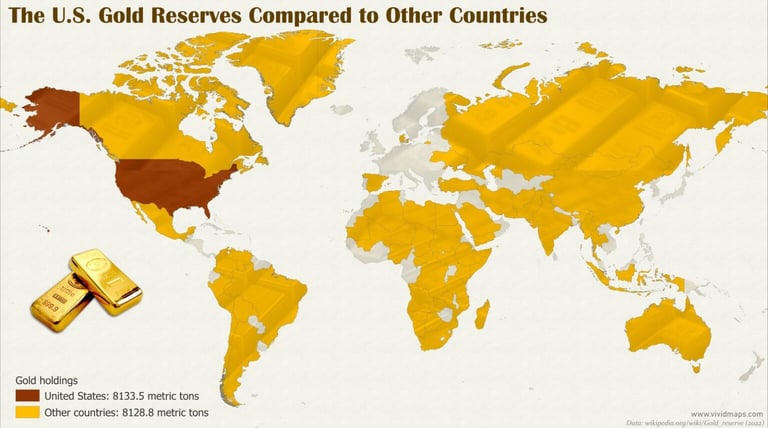Our Elemental Composition: A Grounded Guide to the Nation’s Natural Power
We're getting into the elemental backbone of America—its gold, silver, coal, copper, and more. Learn where they’re found, why they matter, and why every American—especially the old-school, born-and-bred kind—should know what’s under their own soil.
PRECIOUS METALSAMERICAN NATURAL RESOURCES
Illya Burke
10/22/20255 min read


Once upon a time, before “apps” replaced aptitude, every American knew what this land was made of. Folks could look at a hunk of rock and tell if it was worth something. Fast forward to today—ask a teenager to test if a silver coin is real, and you’ll get a blank stare before they start humming a Drake lyric. That, right there, is part of the problem. We’ve become disconnected from what actually gives this country its worth—the literal elements beneath our boots.
America: The Elemental Powerhouse
The United States isn’t just a consumer nation—it’s a geological goldmine. With an estimated $45 trillion in natural resources (thanks, Investopedia), the U.S. ranks second only to Russia in overall wealth from the earth. And remember—Russia’s landmass dwarfs ours. Meaning, per square mile, we’re doing pretty damn good.
Almost 90% of that value comes from timber and coal, which might not sound flashy but built the backbone of this nation—steel mills, railroads, factories, homes. Coal lit the furnaces that built the industrial age, and to this day, America holds the largest proven coal reserves in the world
The Metals That Made America
Iron
Found throughout the Midwest, especially in Minnesota’s Mesabi Range, iron built America’s skyscrapers, bridges, and locomotives. It’s the quiet, unglamorous workhorse metal—strong, steady, reliable. Just like the generations who mined it.
Copper
Head west to Arizona—nicknamed the Copper State for a reason. Copper conducts the electricity that powers your lights, your phone, your life. Without it, your gadgets are just shiny paperweights. Fun fact: Arizona, New Mexico, and Utah produce more than two-thirds of America’s copper.
Silver
Silver is the people’s metal—affordable, beautiful, and actually useful. Found in Nevada, Idaho, and Alaska, it’s not just for coins and jewelry anymore. Silver drives modern tech: solar panels, electric vehicles, and even medical equipment rely on it.
That’s why more Americans own silver than gold—it’s the blue-collar bullion, the accessible investment that anyone can start stacking.
Gold
Gold, meanwhile, is the old reliable. Found in Nevada (America’s top gold state), Alaska, and California, gold remains the global symbol of wealth and stability. Its market is larger, more liquid, and more recognized than any other metal. While silver might be the people’s choice, gold is the fortress—the hedge when the economy looks shaky.
Tin, Nickel & Friends
While not as headline-grabbing, tin, nickel, lead, and zinc keep America’s industries ticking. They’re tucked away in pockets across Alaska, Missouri, and Tennessee, powering batteries, alloys, and tech that make up the gears of the modern machine.
The Precious and the Practical
While gold and silver dominate the spotlight, platinum and palladium also play their part—rare, valuable, and essential for catalytic converters and electronics. These metals are mainly found in Montana and Alaska, but due to their dryness and smaller market, they remain niche investments.
Meanwhile, industrial minerals like bauxite (for aluminum), phosphate (for fertilizer), and talc (for manufacturing) keep everyday life moving quietly behind the scenes.
Beyond Metals: America’s Renewable Core
Let’s not forget the natural lifelines—timber, water, and farmland. America’s forests stretch across the Pacific Northwest, the Appalachians, and the South. Our freshwater sources—like the Great Lakes—are among the largest reserves of drinkable water on Earth. Add in wind corridors through the Plains and solar-rich deserts in the Southwest, and you start to see the full picture: America isn’t just built on resources; it is a resource.
Why Every American Should Care
Because these elements aren’t just commodities—they’re our inheritance. They power our cities, fill our wallets, and shape our identity. Every ounce of gold, every vein of copper, every acre of timber tells a story about the country’s muscle and ingenuity.
It’s easy to forget that when life’s lived through a screen. But the truth is, this land is still alive. It hums beneath our highways, glitters in our rivers, and crackles in our infrastructure. Knowing where it all comes from is more than trivia—it’s patriotism of the purest kind.
Final Word
The old guard Americans—the ones who built, dug, smelted, and hauled—understood the power of the elements. They didn’t need to “Google” where gold came from—they found it. They didn’t just invest—they worked the ground. Nobody on my end is insinuating that all Americans need to memorize a ton of “useless information,” because #1: this damn sure ain’t useless—it’s relevant—and #2: more importantly, only patriots need apply. Iykyk; maybe it’s time we all got back to that.
Learn your land. Respect your resources. Know your metals. Because America isn’t just red, white, and blue—it’s iron, silver, copper, and gold, too.
The U.S. holds the largest gold reserve in the world and is currently at $42.00 per ounce.
The Lifeblood: America’s Fluid & Gas Resources
Now let’s talk about the stuff that keeps the lights on and the wheels turning—the fluid and gaseous side of America’s natural wealth. These aren’t shiny metals you can hold in your hand, but they fuel every industry, household, and cross-country drive.
Natural Gas
The single largest source of electrical generation in the United States. Major production flows from Texas, Pennsylvania, and offshore operations in the Gulf of Mexico. Clean-burning and versatile, it’s America’s go-to bridge between fossil fuels and the renewable era.
Oil
Love it or hate it, oil runs the show. The U.S. is one of the world’s top producers, with powerhouse extraction fields across Texas, North Dakota, Alaska, and deepwater rigs in the Gulf of Mexico. It fuels our freedom of movement—literally.
Coal
As old-school as it gets, and still essential. The Appalachian region holds the richest seams, with states like West Virginia, Pennsylvania, and Kentucky providing the energy that forged the modern world.
Shale Gas
The quiet revolution. Hidden in shale formations stretching across the country, with major plays like the Barnett Shale in Texas and the Marcellus Shale under the Appalachian Basin. Shale gas transformed America into an energy superpower—one that no longer has to bow to foreign oil.
Synthetic Natural Gas
When innovation meets necessity. Produced from coal at places like the Great Plains Synfuels Plant in North Dakota, this synthetic form of natural gas proves American ingenuity can keep the energy flowing even when traditional wells run dry.
These resources—gas, oil, coal, shale—aren’t just economic engines. They’re part of our national DNA. They’ve built cities, fueled wars, lit homes, and powered dreams since the dawn of the industrial age.






